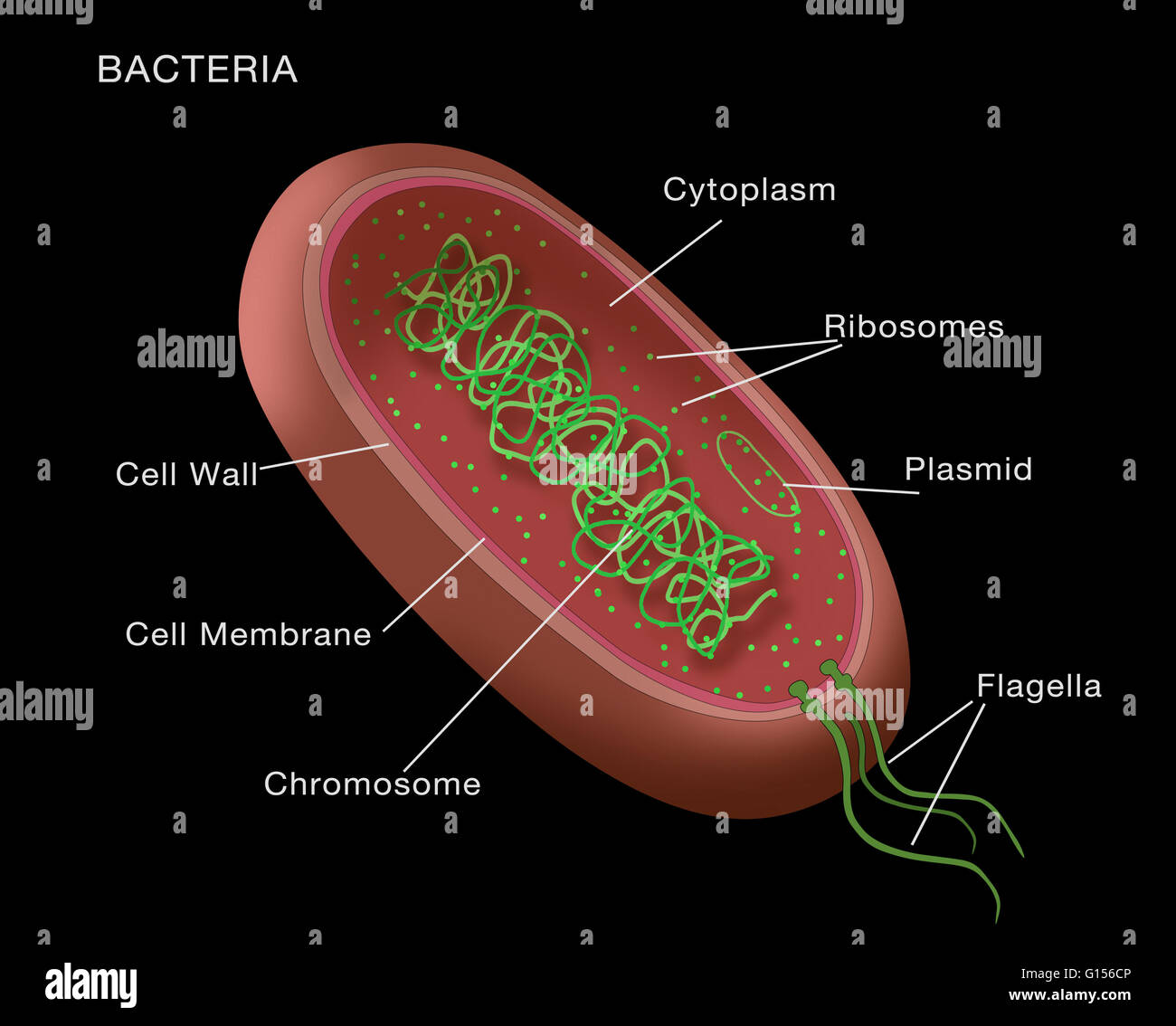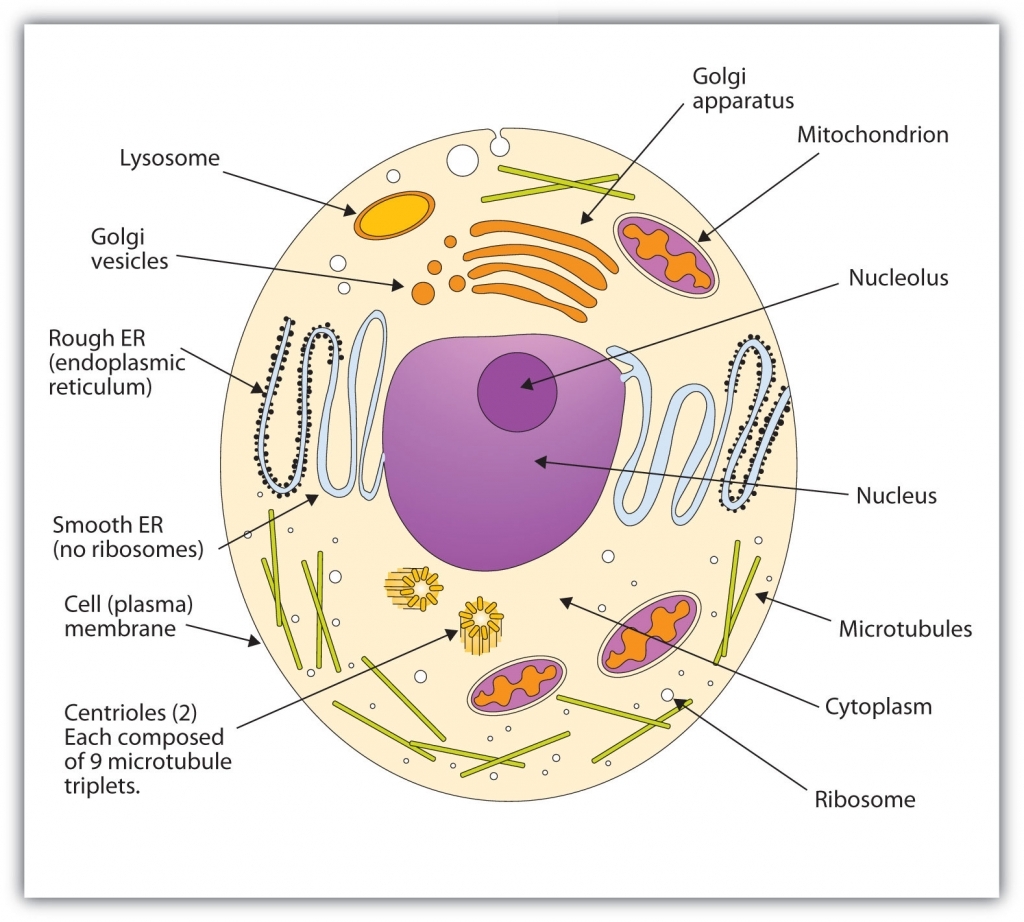Imagine a bustling city, teeming with life and activity. Now, shrink that image down to the size of a grain of sand, and you’ll begin to grasp the incredible complexity of a single cell. These tiny structures, the fundamental building blocks of life, are miniature factories churning out energy, proteins, and more, all while maintaining a delicate balance within their membrane-bound walls. Understanding the parts of a typical cell is akin to unraveling the intricate workings of this invisible metropolis, revealing the secrets that make life possible.

Image: www.alamy.com
This guide will take you on a journey through the inner workings of a cell, labeling and exploring each component. We’ll dissect the essential structures, from the powerhouse mitochondria to the DNA-containing nucleus, offering a glimpse into the dynamic world that lies at the core of all life.
The Cell Membrane: The City Walls
Imagine a bustling metropolis contained within a sturdy wall, regulating the flow of people and resources. The cell membrane serves a similar function, acting as a selective barrier that controls what enters and exits the cell. This delicate structure, composed primarily of phospholipids, forms a flexible boundary that separates the cell’s internal environment from its external surroundings.
The cell membrane is not a static wall but rather a dynamic structure, constantly changing and adapting to the cell’s needs. It features embedded proteins, like gates and checkpoints, which perform specific functions. These proteins act as transporters, ferrying nutrients in and waste products out, while others serve as receptors, receiving signals from the outside world.
The Cytoplasm: The City’s Bustling Streets
Now picture a sprawling city with streets teeming with activity – people commuting to work, cars transporting goods, and bustling marketplaces. The cytoplasm within a cell acts as this vibrant hub, a jelly-like substance that fills the space between the cell membrane and the nucleus. This dynamic environment is where the cell’s essential processes unfold.
The cytoplasm is not just a passive medium; it’s a dynamic workshop where essential organelles, the specialized structures within the cell, perform their vital roles. Here, ribosomes, the protein-making factories, churn out amino acid chains, while the Golgi apparatus, the cell’s packaging and shipping center, modifies and sorts proteins for their designated destinations.
The Nucleus: The City Hall
Just as a city hall governs the operations of a city, the nucleus serves as the control center of the cell, containing the genetic blueprint that directs all cellular activities. It’s enclosed within a double membrane, the nuclear envelope, which acts as a protective barrier for the cell’s precious genetic material – DNA.
The DNA, compacted into structures called chromosomes, houses the instructions for building and maintaining the entire organism. This intricate code contains the recipe for all the proteins the cell needs to function, from enzymes that catalyze reactions to structural components that provide support. The nucleus is the blueprint for life itself.

Image: getdrawings.com
The Ribosomes: The Cell’s Protein Factories
Think of the many factories within a city, producing everything from automobiles to household goods. Ribosomes within a cell perform a similar function, serving as protein-making factories. These tiny organelles, composed of RNA and protein, are found in the cytoplasm and attached to the endoplasmic reticulum (ER).
Ribosomes read the genetic instructions carried by messenger RNA (mRNA) and translate them into a string of amino acids. These chains, in turn, fold into complex three-dimensional shapes, generating the proteins that perform a multitude of essential functions within the cell.
The Endoplasmic Reticulum (ER): The City’s Infrastructure
Just as a city relies on a network of roads and bridges to transport goods and people, the endoplasmic reticulum (ER) serves as the cell’s transport system. This intricate network of interconnected membranes extends throughout the cytoplasm, providing a pathway for the movement of molecules.
The ER comes in two forms: rough ER and smooth ER. Rough ER, studded with ribosomes, is primarily responsible for protein synthesis and modification. Smooth ER, devoid of ribosomes, plays a role in lipid (fat) metabolism, detoxification, and calcium storage. The ER ensures smooth coordination of cellular processes, enabling the cell to function as a cohesive unit.
The Golgi Apparatus: The Cell’s Packaging and Shipping Center
Think of a busy postal service, sorting and packaging mail for delivery to various destinations. The Golgi apparatus within a cell performs a similar role, acting as the cell’s packaging and shipping center. This intricate structure consists of flattened sacs, called cisternae, stacked one atop another.
Incoming proteins from the ER arrive at the Golgi apparatus, where they are further processed, sorted, and packaged into membrane-bound vesicles. These vesicles, like tiny delivery trucks, transport their cargo to various destinations within the cell or outside the cell.
The Mitochondria: The Cell’s Powerhouses
Imagine a bustling city relying on a network of power plants to generate electricity. Mitochondria, small organelles with their own DNA, serve as the cell’s powerhouses, producing energy in the form of ATP (adenosine triphosphate) through cellular respiration. This process breaks down glucose and other fuels in the presence of oxygen, releasing energy that powers the cell’s activities.
Mitochondria are particularly fascinating because they possess their own DNA, separate from the cell’s nucleus. This suggests that mitochondria were once independent organisms, incorporated into eukaryotic cells through a process called endosymbiosis. They play a crucial role, ensuring the cellular machinery has the energy it needs to function.
Lysosomes: The Cell’s Recycling Centers
Think of a city’s garbage disposal system, efficiently breaking down waste and removing harmful materials. Lysosomes within a cell perform a similar function, acting as the cell’s recycling centers. These small, spherical organelles contain powerful enzymes that digest and break down cellular waste products, worn-out organelles, and invading pathogens.
Lysosomes play a vital role in maintaining a clean and efficient cellular environment, ensuring that the cell does not become overwhelmed by waste. They also have a role in programmed cell death, a process by which cells self-destruct when they are damaged or no longer needed.
Vacuoles: The Cell’s Storage Tanks
Imagine a city with vast reservoirs and underground tanks, storing water and resources for the population. Vacuoles in a cell perform a similar function, acting as storage tanks for various substances. In plant cells, vacuoles are particularly large, filling much of the cell’s volume and providing structural support.
Vacuoles store water, nutrients, waste products, and pigments. They play a crucial role in a plant’s ability to maintain turgor pressure, the internal pressure that allows plants to stand upright. Vacuoles also participate in various cellular processes, from maintaining pH balance to detoxifying harmful substances.
The Cell Wall (Plant cells): The City’s Defensive Walls
While animal cells rely on the cell membrane for structure, plant cells have an additional layer, the cell wall, that provides extra support and protection. This rigid structure, made up of cellulose, is located outside the cell membrane and acts like a sturdy wall, providing stability and preventing the cell from bursting due to internal pressure.
The cell wall also helps to regulate the exchange of substances between the cell and its environment. It forms a barrier against invading pathogens and provides a rigid framework that allows plants to grow and maintain their shape.
Label The Parts Of A Typical Cell
Understanding the Cell: A Foundation for Life
By delving into the inner workings of a typical cell, we gain a profound appreciation for the complexity and sophistication of life. From the bustling cytoplasm to the DNA-containing nucleus, each part plays a critical role in the cell’s survival and function. This knowledge forms a foundation for understanding how cells interact, forming tissues, organs, and ultimately, complete organisms.
This exploration of the cell is not just a scientific exercise; it’s a journey into the heart of what it means to be alive. By understanding the cell, we gain a deeper understanding of our own bodies, our environment, and the interconnectedness of all living things.






